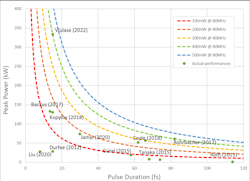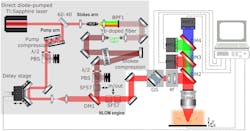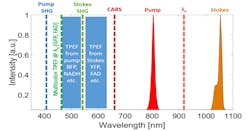A new generation of ultrafast Ti:sapphire lasers is underway
Since the laser’s invention in 1961, it has offered unprecedented opportunities for scientific research and industrial applications, thanks to its unmatched superiority over traditional light sources. Enormous advances in laser performance have been made since, such as shorter laser pulses, higher peak intensities, or more power. The ultrafast laser is the most scientifically sought after.
The titanium-doped sapphire (Ti:sapphire) laser has always been the superstar of ultrafast lasers since its first introduction in 1986, because of its broad gain bandwidth. 40 years later, many other gain media have been used to generate ultrashort laser pulses as well, but none of them can challenge its ability to generate optical pulses as short as 6 fs directly out of a laser cavity. Ti:sapphire ultrafast lasers are still the best candidates to get the shortest pulses.
Will Ti:sapphire be replaced?
Ti:sapphire has its own challenges to become an affordable tool for various applications. Since the pump absorption of Ti:sapphire is located within the blue-green area of the optical spectrum (centered around 490 nm), for a very long time bulky and expensive argon-ion lasers and frequency-doubled solid-state lasers were used as a pump source.
Today’s diode-pumped solid-state (DPSS) lasers use 808 nm diodes to pump a neodymium-doped or semiconductor gain material to generate laser output around 1064 nm, which is then frequency-doubled to 532 nm. All these intermediate steps require a significant amount of space, and introduce losses, heat, and optical noise. Consequently, the Ti:sapphire laser usually comes with a bulky laser head and a huge control unit, not to mention the chiller to remove the excessive heat generated by the complicated frequency conversions. Combined with the high costs (often around $100,000), Ti:sapphire lasers—despite their undisputed performance—have never been an accessible or user-friendly device for daily applications. If these limitations cannot be overcome, Ti:sapphire ultrafast lasers will remain an expensive system with top performance for niche customers.
The apparent lack of compactness and affordability has led many users to opt for ultrafast fiber lasers, because of their compactness, cost, and robustness. With moderate performance compared to Ti:sapphire lasers—that is, pulse duration around 100 fs and average power of a few hundred milliwatts—they are not a suitable alternative for all applications. Nonlinear effects and the limited gain bandwidth prevent ultrafast fiber lasers from competing with Ti:sapphire performance.
How can Ti:sapphire lasers compete with fiber lasers’ affordability and user-friendliness?
The turning point for Ti:sapphire lasers appeared in 2011, when Roth et al. demonstrated the first ultrafast, directly diode-pumped Ti:sapphire laser.1 By replacing the bulky DPSS pump with gallium nitride (GaN) laser diodes, the Ti:sapphire laser has mitigated its biggest weakness. But the GaN laser diodes initially emitted at non-ideal wavelengths, had limited power, and poorer beam quality—so the output power of such a directly diode-pumped system remained quite low.
During the last decade, much effort has been made (see Fig. 1). People have come up with different ideas, such as beam combining or profile shaping, to maximize oscillator output.2–5 However, the typical output power is merely slightly more than 100 mW, with peak power no more than 150 kW. People are looking forward to a system with decent output at a lower cost and smaller footprint.
More recently, the company Viulase (Vienna, Austria) announced a monolithic directly diode-pumped Ti:sapphire ultrafast laser (DDPTL) system called Tenacity. With more than 400 mW of output power at 80 MHz, a peak power of about 400 kW, and pulse duration shorter than 15 fs, the new oscillator shows that a DDPTL can compete with traditional ones in performance. Furthermore, it presents an unprecedented compactness as a laser system slightly bigger than a shoebox, requiring no extra control unit.
Working horse instead of lab rat
Among various applications with femtosecond laser oscillators, nonlinear microscopic imaging is a rather demanding discipline that requires both high peak power and low optical noise from the light source. In a collaboration with the Medical University of Vienna, a powerful direct diode-pumped Ti:sapphire femtosecond laser was used as the main laser source in a multimodal imaging experiment.
To obtain different information from the sample, a multimodal detection, including two-photon excited fluorescence (TPEF) microscopy, second-harmonic generation (SHG) microscopy, and coherent anti-Stokes Raman scattering (CARS) microscopy, was used. In multiphoton microscopy, most often a widely tunable femtosecond laser is set at some specific wavelength to excite enzymes or proteins of the biological tissue. For CARS, photons of different excitation wavelengths are needed, yet can’t be delivered by just a single tunable femtosecond laser. Therefore, in this experiment a sophisticated imaging platform involving multiphoton and CARS microscopy was demonstrated using a single direct diode-pumped femtosecond light source delivering 400 mW of ~50 fs laser pulses (FWHM: 15 nm; see Fig. 2).While the ultrafast pulses centered at 805 nm and 1050 nm can both generate their own second harmonic generation (SHG), the sum frequency of these two beams corresponds to the SHG at 923 nm. These two beams can generate up to six different signals in the sample, including the two-photon excitation fluorescence of three different dyes, SHG and CARS, for extensive information.
Multimodal imaging of Caenorhabditis elegans and zebrafish larvae was successfully done in the experiment and merged images were easily obtained.
This demanding application demonstrated that the output power level and stability performance of a DDPTL is sufficient for most bioimaging applications. We can safely assume as well that those new kinds of femtosecond lasers are also ready to be used in other applications such as terahertz generation and detection, two-photon polymerization, and so on.
Faster, smaller, and higher
Replacing solid-state lasers and integrating everything into one box was only the first step. The potential of the DDPTL goes far beyond.
Pumping with laser diodes not only bypasses sophisticated light frequency conversion stages that potentially add optical noise to the system, but also the servo loop bandwidth of the driving current to stabilize the final output is greatly enhanced. Therefore, any active feedback, such as power stabilization and carrier envelope phase stabilization, can be done much quicker and easier.
Bypassing frequency conversion stages also means that overall heat dissipation is significantly reduced. The much-better wall-plug efficiency could afford a much cheaper and smaller water-cooling unit or even be content with a compact air-cooling system. This allows the ultrafast laser to operate in various scenarios beyond cleanrooms, or even on batteries.
Moreover, with the continuous improvement of output power of green and blue laser diodes, even more powerful diode-pumped ultrafast lasers can be expected in the future, as well as direct diode-pumped ultrafast amplifiers.
We foresee a solid revival and bright future of the ultrafast Ti:sapphire laser in which it will become more accessible to a broader market, in a way that it could be a standard, affordable femtosecond light tool in every laser optics lab. It will be delivered in a package comparable to a shoebox, and the installation is so simple users just need to plug it into a wall socket and it’s ready for operation. In case any service is needed, you can send it back and get it repaired within days. Hence, thanks to these advancements, the ultrafast laser will become ubiquitous in our daily life like mobile phones.
REFERENCES
1. P. W. Roth, A. J. Maclean, D. Burns, and A. J. Kemp, Opt. Lett., 36, 2, 304 (2011); doi:10.1364/ol.36.000304.
2. C. G. Durfee et al., CLEO: Science and Innovations, 20, 13, 1223–1227 (2012).
3. N. Sugiyama, H. Tanaka, and F. Kannari, Jpn. J. Appl. Phys., 57, 5, 0–4 (2018); doi:10.7567/jjap.57.052701.
4. S. Backus, M. Kirchner, C. Durfee, M. Murnane, and H. Kapteyn, Opt. Express, 25, 11, 12469 (2017); doi:10.1364/oe.25.012469.
5. J. C. E. Coyle, A. J. Kemp, J.-M. Hopkins, and A. A. Lagatsky, Opt. Express, 26, 6, 6826 (2018); doi:10.1364/oe.26.006826.


